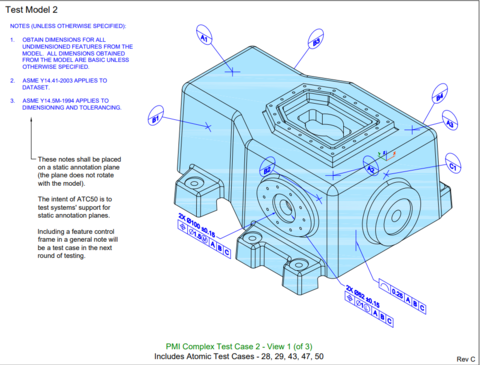
Graphical PMI visualized by the STEP File Analyzer and Viewer.
STEP (ISO 10303) is a widely-used standard for representing and exchanging data about manufactured parts and assemblies. NIST and the Systems Integration Division (SID) provided leadership for the first release of STEP in 1994, and continue to work to this day with the International Organization for Standardization (ISO) to extend the scope of the standard to cover more product-related data. SID also creates and maintains tools that make it easier for manufacturers, especially small- and medium-sized ones, to create and use STEP files and for software vendors to verify the contents of a STEP file. The most popular of these tools is the STEP File Analyzer and Viewer. The STEP File Analyzer and Viewer was created in 2012 and is continuously updated to fix bugs for new versions of the STEP standard, and to inform recommended practices for implementations. The most recent update, version 4.55, was released in August.
In a nutshell, STEP files are used to describe an ever-growing body of product information—like part geometry, tolerances, and assembly instructions—in a neutral format that can be exchanged between computer-aided systems, like computer-aided design (CAD) and computer-aided manufacturing , and integrate those designs into the broader enterprise systems.
Engineers need a neutral format for describing and exchanging information about a product. Such a format lets engineering systems communicate with one another, making them more interoperable and efficient. Before the STEP standard was created, software vendors created physical and digital blueprints of products that they could read easily, but other vendors could not. This decreased efficiency in several ways. First, vendors in one part of a company were not able to share their designs with vendors in another part of the company. It also made it difficult for small- and medium-sized manufacturers to get blueprint information out of product designs, seriously limiting their ability to create their own designs and implement designs from existing products.
The STEP Analyzer and Viewer has been a key tool for creating, finding, and analyzing information in STEP files. One part of the tool, the STEP File Analyzer, checks files for conformance with the STEP standard and recommended practices for implementation. The recommended practices for conforming to the STEP standard are very complex, and before the STEP File Analyzer and Viewer, it was difficult for software vendors to confirm that their STEP files followed these practices. The second part of the tool, the STEP File Viewer, lets the user get visual confirmation of the contents of a STEP file.
The STEP File Analyzer and Viewer is one of many tools that the System Integration Division has developed to support standards and best practices for working with data for manufacturing systems. You can find others on our software page.

